The Intel Core i3-7350K (60W) Review: Almost a Core i7-2600K
by Ian Cutress on February 3, 2017 8:00 AM ESTProfessional Performance: Windows
Agisoft Photoscan – 2D to 3D Image Manipulation: link
Agisoft Photoscan creates 3D models from 2D images, a process which is very computationally expensive. The algorithm is split into four distinct phases, and different phases of the model reconstruction require either fast memory, fast IPC, more cores, or even OpenCL compute devices to hand. Agisoft supplied us with a special version of the software to script the process, where we take 50 images of a stately home and convert it into a medium quality model. This benchmark typically takes around 15-20 minutes on a high-end PC on the CPU alone, with GPUs reducing the time.
Here we report the overall time to complete the test – sub-test results can be found in Bench.
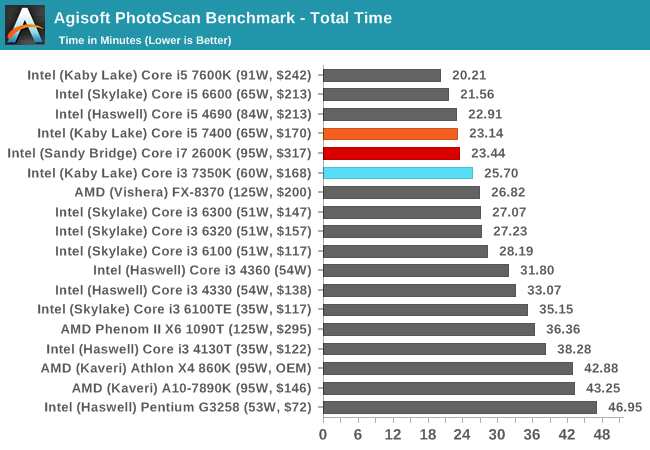
Photoscan is a mix of single and multi-threaded segments, but overall the extra cores in the i5/i7 beat the Core i3, but not by much.
Cinebench R15
Cinebench is a benchmark based around Cinema 4D, and is fairly well known among enthusiasts for stressing the CPU for a provided workload. Results are given as a score, where higher is better.
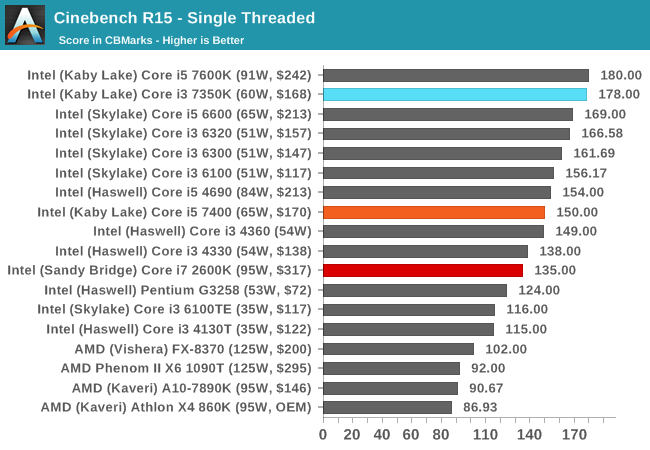
All the Kaby Lake processors seem to do well in CB15 single threaded performance, given that all the K-processors can reach 4.2 GHz or higher one way or another. Nonetheless, the age of the Core i7-2600K is showing here.
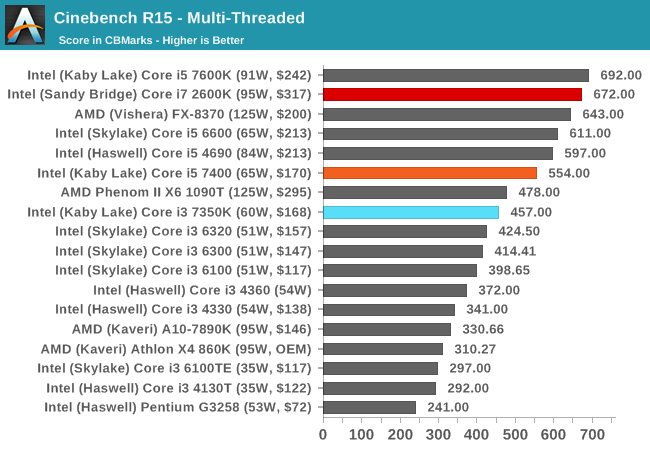
Turning the tables with actual cores, and the Core i7-2600K gets a significant leg up here. The Core i5 also sits above the Core i3.
HandBrake v0.9.9: link
For HandBrake, we take two videos (a 2h20 640x266 DVD rip and a 10min double UHD 3840x4320 animation short) and convert them to x264 format in an MP4 container. Results are given in terms of the frames per second processed, and HandBrake uses as many threads as possible.
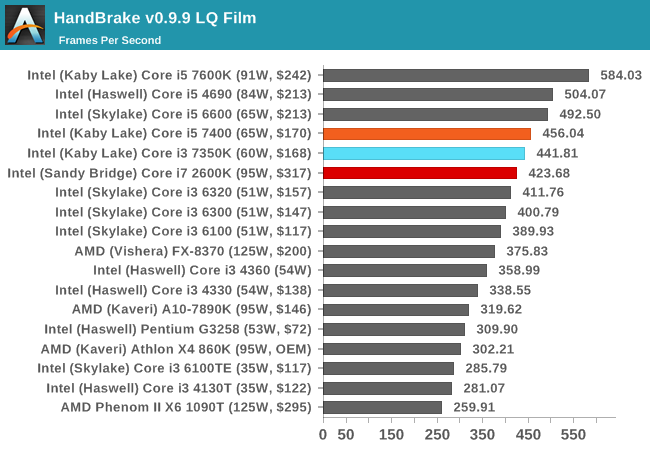

For video conversion, having small frames puts all three CPUs in a similar spot. But ramp up the frame size and we see the Kaby Lake i5 pull ahead due to IPC and instructions. The Core i3 has enough oomph to match the extra threads on the Core i7-2600K though.
Hybrid x265
Hybrid is a new benchmark, where we take a 4K 1500 frame video and convert it into an x265 format without audio. Results are given in frames per second.
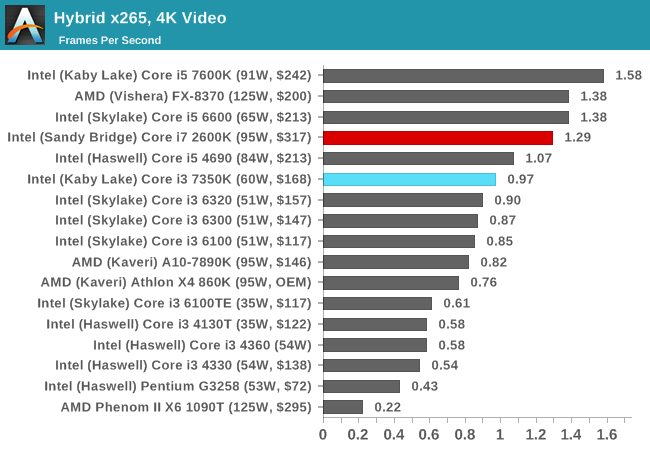
With a different video conversion tool and render, the extra cores and threads of the Core i7 is more than enough to give it a 30% advantage over the Core i3-7350K. It makes me wonder if another +30% frequency would help the Core i3.










186 Comments
View All Comments
Ian Cutress - Friday, February 3, 2017 - link
Next test bed update will be on W10. I keep getting mixed reactions recently from W10/W7/Linux users on this front - some want to see W10 poweeeeeer, others want default. But for DX12 it'll have to change over.CaedenV - Friday, February 3, 2017 - link
Bench-marking in win10 is... well... difficult. The OS has too many automatic features, so it is hard to get consistent results. You still get better overall performance... but not consistent performance. Win7 is gloriously dumb and gives very clear numbers to make very easy comparisons.Flunk - Friday, February 3, 2017 - link
It's a bit sad that you can compare any CPU from 2011 to one from 2017 and have them match up like this. In the 90's a CPU that was 6 years newer was many times faster than the older one. Is it lack of competition? Or have we just hit the wall with silicon chip technology?Ro_Ja - Friday, February 3, 2017 - link
Back in the days it was all about higher clock speed = faster. Nowadays it's a bit complex for me :\BrokenCrayons - Friday, February 3, 2017 - link
It's probably a combination of both, but I'd go out on a limb and say it's mostly due to technology and not so much market forces. Intel's primary competition for new processor models really ends up being its own prior generations It the company wants to land sales, it needs to offer a compelling incentive to upgrade.There's also Intel's efforts to reduce TDP over successive generations (something the company would probably not do were there more credible competitive forces in the market). Those reductions are probably a side effect of a mobile-first perspective in modern CPU design, but there's something nice about buying a reasonably power 35W desktop processor and not having to worry about copper-pipe festooned tower coolers with 120mm fans strapped on them just to keep your chip happy. If I were to build a new desktop, I'd entertain a T-series part before exploring any other option.
StrangerGuy - Friday, February 3, 2017 - link
It's funny we got big perf/watt increases over the past few years in CPUs and GPUs, yet somehow everyone are still buying massive overkill 650W+ PSUs where most systems would struggle to even draw 1/3 of the PSU rated wattage at load.I'm pretty confident that an undervolted i5 7400 and GTX 1060 (60W @ 1600MHz according to THG) would be able to draw <100W at the wall in a normal gaming load with an efficient enough PSU...
fanofanand - Friday, February 3, 2017 - link
Because MOAR POWER and marketing. Seriously, they sell the high power PSUs for a LOT more than the lower powered PSUs, it's going to take consumers buying the 300-450W psu's en masse before the manufacturers adjust. Your theoretical operates under false assumptions however. The 1060 boosts up well beyond 1600 and will consume far more than 60 watts, and there are efficiency losses in the PSU and throughout your system. Go ahead and try to run a 1060 and an undervolted i5, see what happens.t.s - Friday, February 3, 2017 - link
He said normal gaming. His number is quite possible --with good mobo, ssd, no optical drive.fanofanand - Friday, February 3, 2017 - link
No, it's not. For typical gaming the 1060 consumes between 90-120 watts. So please do tell me how his system with a 100 watt GPU is going to consume less than 100 watts with a CPU, mobo, RAM, etc.?hybrid2d4x4 - Friday, February 3, 2017 - link
As a point of reference, I have a 1060 in a i5 4670 system running a 400W Platinum PSU. All stock clocks, 1 SSD, 1 HDD. Peak power in games measured at the wall is ~200W (180-200 depending on which AAA game), so I doubt <100W is doable.But agree with the commentary about how overkill most PSUs are.